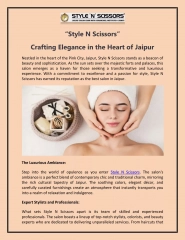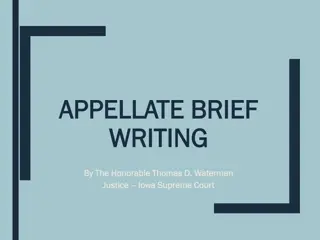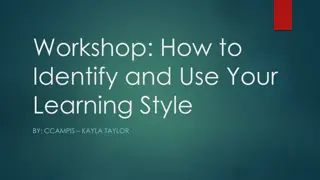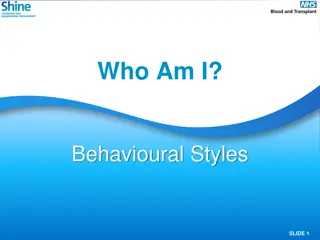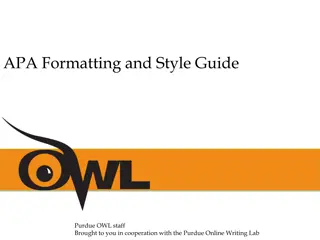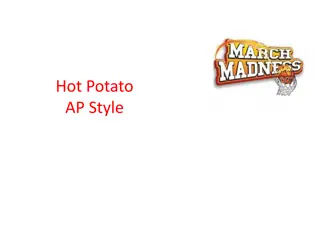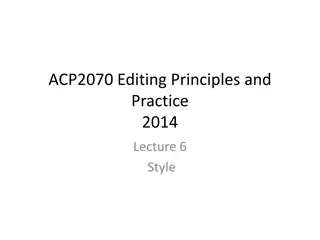
Troubleshooting Confusing Sentences: Reasons & Solutions
Understand why certain sentences can be confusing and learn how to improve clarity by addressing issues such as subject-verb distance, complex subjects, and nominalizations. Enhance your writing skills with practical tips from writing specialists.
Download Presentation

Please find below an Image/Link to download the presentation.
The content on the website is provided AS IS for your information and personal use only. It may not be sold, licensed, or shared on other websites without obtaining consent from the author. If you encounter any issues during the download, it is possible that the publisher has removed the file from their server.
You are allowed to download the files provided on this website for personal or commercial use, subject to the condition that they are used lawfully. All files are the property of their respective owners.
The content on the website is provided AS IS for your information and personal use only. It may not be sold, licensed, or shared on other websites without obtaining consent from the author.
E N D
Presentation Transcript
STYLE & CLARITY OMAR HUSSEIN GRADUATE WRITING SPECIALIST THE CSULB GRADUATE CENTER
PRELIMINARIES First, since a competent writer usually knows his subject matter very well, perhaps too well, he is systematically handicapped in anticipating how easily readers will make sense of his text. Second, since a writer usually overestimates how much readers know, a writer should give readers more help than he thinks they need. Williams & Colomb (1990), Style: Toward Clarity and Grace The following slides borrow and steal shamelessly from Style and other related works by Joseph Williams and company. I note the sources (as I m doing here) but I don t always use proper citation.
WHY IS THIS SENTENCE CONFUSING? Decisions in regard to the administration of medication despite the inability of irrational patients voluntarily appearing in Trauma Centers to provide legal consent rest with a physician alone. (this is example is from Williams & Colomb, 1990, cited earlier)
REASON #1: DISTANCE BETWEEN SUBJECT AND MAIN VERB Decisions in regard to the administration of medication despite the inability of irrational patients voluntarily appearing in Trauma Centers to provide legal consent rest with a physician alone. The simple subject (decisions) is far apart from the main verb (rest).
REASON #2: COMPLEX SUBJECT Decisions in regard to the administration of medication despite the inability of irrational patients voluntarily appearing in Trauma Centers to provide legal consent rest with a physician alone. The subject is a long, phrase (which is why the simple subject and main verb are so far apart). The payoff only comes at the end.
REASON #3: ACTIONS ARE IN NOUN FORM (NOMINALIZATIONS) Decisions in regard to the administration of medication despite the inability of irrational patients voluntarily appearing in Trauma Centers to provide legal consent rest with a physician alone. Nominalizations are noun-ified words. So, for example, the verb to calibrate is an action. It s something that someone does: I need to calibrate the sensor or Jane calibrated the sensor. But you can also nominalize calibrate to make the abstract noun calibration. I need to perform a calibration of the sensor or Jane performed a calibration of the sensor. Nominalizations are OK to use, but too many of them make your writing hard to read. Reminder: Nouns are thing words. Examples: Einstein, apple, uncertainty (an abstract thing, but still a thing). Verbs are action and being words. Examples: is, are, run, live, think.
HOW CAN WE FIX IT? There are other problems we could talk about, but those are a good start. So, how could we revise the sentence to make it clearer and easier to read? Decisions in regard to the administration of medication despite the inability of irrational patients voluntarily appearing in Trauma Centers to provide legal consent rest with a physician alone.
ONE POSSIBLE FIX Original: Decisions in regard to the administration of medication despite the inability of irrational patients voluntarily appearing in Trauma Centers to provide legal consent rest with a physician alone. Revised: Only physicians can decide to administer medication to irrational patients in Trauma Centers who are unable to provide legal consent. The rest of this presentation will focus on ways to make your writing as clear and accessible as possible. I ll call them style and clarity tips but some of them are more like principles.
FIRST, A POINT OF CLARIFICATION I m not talking about dumbing down your meaning. To illustrate: Can you spot a trend in this data? t (time)=15 , T (temperature)=32 ; t=0 , T=25 ; t=6 , T=29 ; t=3 , T=27 ; t=12 , T=32 ; t=9 , T=31 Source: Gopen, G. D. & Swan, J. A. (1990). The science of scientific writing. American Scientist, xi. Retrieved from https://www.e- education.psu.edu/styleforstudents/c10_p1.html
HOW ABOUT NOW? The point? Good organization can help you convey your message clearly without sacrificing detail or complexity.
TIP #1: THINK ABOUT THE READER (ADAPTED FROM LARRY MCENERNEY) No writing advice makes any sense unless we specify (1) who will be reading it (the audience) and (2) why they will be reading it (the audience s purpose). Most advice you get is text-based. For example, don t use the passive voice. This advice ( Don t use the passive voice ) is not just bad. It is absurd. Active voice: The thief stole the money. The subject (thief) performs the action of the verb (stole). Passive voice: The money was stolen by the thief. The subject (money) DOES NOT perform the action of the verb (stole). Passive voice can be very useful, or not, depending on who s reading the text and what they expect to get out of the text (i.e. the function of the text).
TIP #1: THINK ABOUT THE READER (CONTINUED) Example: Bob the lab guy You wouldn t write this in a research article: Bob the lab assistant fashioned me a specific piece of glassware as shown in figure 4. Why? Because the readers of your journal article don t care about Bob the lab guy. You d write something like this: A piece of glassware, as shown in figure 4, was fashioned for the purpose of the experiment. This is a good use of the passive voice BECAUSE of who the intended readers are. Avoid text-based advice. Instead, think in terms of the reader.
TIP #2: MAKE THE MAIN CHARACTER IN YOUR STORY THE SUBJECT OF YOUR SENTENCE. Sentences tell stories. So, your grammatical subject should be the main character in your story. Contrast these 2 sentences: William Tell shot the apple off his friend s head. That students retained more information when classroom activities involved student-directed inquiry was one of the key facts revealed by the analysis. The first sentence tells us that a character ( William Tell ) took some action ( shot ). The second sentence buries the main character ( analysis ) at the end. Re-write: The analysis revealed that students retained more information when classroom activities involved student-directed inquiry.
TIP #2: PRACTICE How can we revise this sentence (to make the main character the subject)? That the U.S. government was dishonest to the public regarding the progress of the war in Afghanistan was one of the key revelations of the Afghanistan Papers. Posing, analyzing, and attempting to answer ethical questions in an exacting logical manner is an important role played by philosophy, and one that often sets it apart from other humanities disciplines.
TIP #2: POSSIBLE ANSWERS The Afghanistan Papers revealed that the U.S. government was dishonest to the public regarding the progress of the war in Afghanistan. Philosophy plays an important role in posing, analyzing, and attempting to answer ethical questions in an exacting logical manner a role that often sets it apart from other humanities disciplines. Notice that making the main character the subject of the sentence also brings the subject and verb closer together, which leads to the next tip...
TIP #3: KEEP SUBJECTS AND VERBS CLOSE TOGETHER English readers expect doers to be near their actions. The big fish eats the little fish. Complex subjects (or subjects modified with long clauses) tend to violate this expectation. The big fish, although not, at the moment, hungry, as a result of having eaten a whole school of smaller fish less than an hour before, but feeling it within his nature seeing that he was quite evil to devour another fish simply to prove a point to onlookers, eats the little fish.
TIP #3: PRACTICE How can we revise this sentence to bring the simple subject closer to the main verb? DNA in repeat regions or with long stretches of the same base or small microsatellites causes problems for next-gen sequencers.
TIP #3: POSSIBLE ANSWER Original: DNA in repeat regions or with long stretches of the same base or small microsatellites causes problems for next-gen sequencers. Revised: DNA causes problems for next-gen sequencers when it is in repeat regions or has long stretches of the same base or small microsatellites.
TIP #4: PUT ACTIONS IN VERB FORM In other words, avoid too many nominalizations or nounified words: The word nominalization is a nominalization of the verb to nominalize. Implacable (adjective) implacability (noun) Calibrate (verb) calibration (noun) Crony (noun) cronyism (a more abstract noun) Some nominalizations are helpful. But using too many reduces clarity: -Writers who overload their sentences with nominalizations tend to sound pompous and abstract. -The proliferation of nominalizations in a discursive formation may be an indication of a tendency toward pomposity and abstraction
TIP #4: PUT ACTIONS IN VERB FORM (CONTINUED) Some misuses of nominalizations and how to fix them. We performed an analysis We analyzed The quantification of the atoms was done. The atoms were quantified. The MS managed the measurement and identification of the proteins. The MS measured and identified the proteins.
TIP #4: PRACTICE How can we revise this sentence by putting actions in verb form (i.e., removing unnecessary nominalizations)? (hint: it s OK to also move the subject) Detailed analyses of the evolutionary features of different types of regulatory elements are an important area for future research.
TIP #4: POSSIBLE ANSWER Original: Detailed analyses of the evolutionary features of different types of regulatory elements are an important area for future research. Revised: Future research should analyze the evolutionary features of different types of regulatory elements. Notice that the revised version also brings the subject and verb closer together. The revised sentence is also shorter (which, all things being equal, is a plus!).
TIP #5: OMIT UNNECESSARY WORDS In academic writing, shorter is usually better. As Stephen King likes to say, you can omit almost all adjectives (e.g., a very big car ) and adverbs (e.g., he ran quickly ). As I like to say, the more words you have, the more opportunities you have to confuse the reader. Some examples: It is absolutely vital that We must At the same time Simultaneously/furthermore There were five mice receiving antibiotics Five mice received antibiotics. Reminder: Adjectives modify nouns (things): A big, red, hatchback car Adverbs modify verbs, adjectives, and other adverbs: A very big car that runs smoothly
TIP #5: PRACTICE How can we eliminate the unnecessary words in this passage? (while you re at it, you can fix other problems too). Some astonishing questions about the nature of the universe have been raised by scientists studying the nature of black holes in space. The collapse of a dead star into a point perhaps no larger than a marble creates a black hole.
TIP #5: POSSIBLE ANSWER Original: Some astonishing questions about the nature of the universe have been raised by scientists studying the nature of black holes in space. The collapse of a dead star into a point perhaps no larger than a marble creates a black hole. Revised: Scientists studying black holes have raised astonishing questions about the universe. A black hole is created by the collapse of a dead star into a point no larger than a marble.
TIP #6: MOVE FROM OLD INFO TO NEW INFO Readers expect sentences to start with familiar ( old ) ideas and end with unfamiliar ( new ) ideas. Example: One upon a time there were three little pigs. Scrappy, Sparky, and Spanky were their names. Bricklaying is a difficult job, but Scrappy was very good at it. Poetry is totally different from bricklaying, and poetry was Sparky s passion. Weird, and a bit confusing, right?
TIP #6: MOVE FROM OLD INFO TO NEW INFO Original: One upon a time there were three little pigs. Scrappy, Sparky, and Spanky were their names. Bricklaying is a difficult job, but Scrappy was very good at it. Poetry is totally different from bricklaying, and poetry was Sparky s passion. Better: One upon a time there were three little pigs. The pigs names were Scrappy, Sparky, and Spanky. Scrappy was a bricklayer. Bricklaying is a difficult job, but Scrappy was very good at it. Another thing that Scrappy was good at was poetry, his true passion, which is totally different from bricklaying.
TIP #6: PRACTICE How can we revise this passage to improve the old-to-new information flow? Farmers try to provide optimal growing conditions for crops by using soil additives to adjust soil pH. Garden lime, or agricultural limestone, is made from pulverized chalk, and can be used to raise the pH of the soil. Clay, which is a naturally acidic soil type, often requires addition of agricultural lime. Source: Sheffield, N. (2011). Scientific Writing: Clarity, Conciseness, and Cohesion. Duke Writing Studio. Retrieved from https://cgi.duke.edu/web/sciwriting/resources/201108_DukeScientificWritingWorkshop.pdf
TIP #6: POSSIBLE ANSWER Original: Farmers try to provide optimal growing conditions for crops by using soil additives to adjust soil pH.Garden lime, or agricultural limestone, is made from pulverized chalk, and can be used to raise the pH of the soil. Clay, which is a naturally acidic soil type, often requires addition of agricultural lime. Revised: Farmers try to provide optimal growing conditions for crops by using soil additives to adjust soil pH. One way to raise the pH of the soil is an additive made from pulverized chalk called garden lime or agricultural limestone. Agricultural limestone is often added to naturally acidic soils, such as clay.
REVIEW Tip 1: Think about your readers What do they want? What do they need? and avoid text-based advice. Tip 2: Make the main character (or do-er ) the subject of the sentence. Tip 3: Keep subjects (do-ers) close to verbs (actions); check for subject-verb distance. Tip 4: Put actions in verb form; find nominalizations and see if they should be converted to verbs. Tip 5: Omit unnecessary words. Tip 6: Move from old info to new info. Put familiar information early in the sentence and new information later in the sentence.

